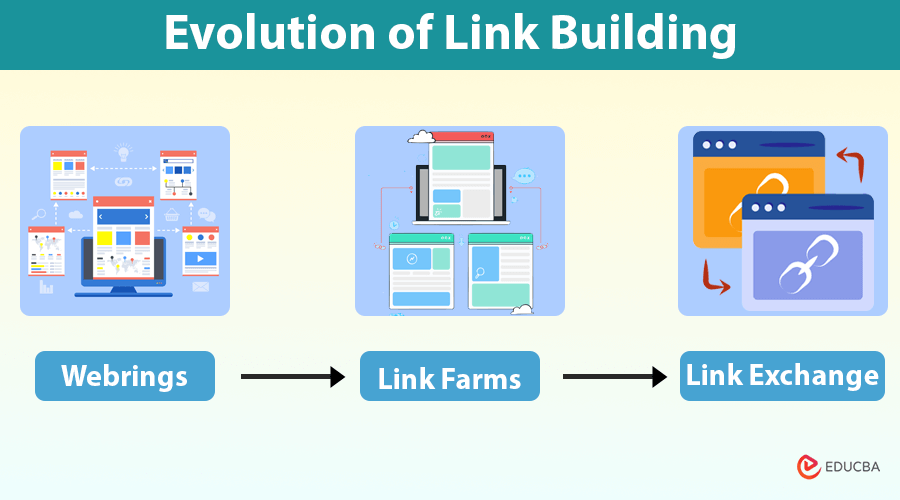Introduction to the Evolution of Link Building
The internet and the technologies that power it are always evolving due to constant innovations and changing consumer behavior. Similarly, major search engines rely on backlinks and other factors to determine search engine rankings. It is because a web page with many high-quality backlinks pointing to it signals to search engine algorithms that it’s credible, trusted, and of high value. Let us understand the evolution of link building in this article.
Understanding Link Building
Link building is a search engine technique where websites create links that redirect the website’s visitors from other sites to your website.
Types of links:
- Inbound Links: Links that point readers to pages within the same website.
- Backlinks: Links that direct readers to other websites.
Key points:
- After developing a website, it is insufficient to simply wait for other websites or blogs to provide backlinks.
- While high-quality content that delivers substantial value to your target audience may organically attract links from websites within the same niche, relying solely on this approach can be risky.
- To ensure consistent backlink acquisition, it is advisable to strategically collaborate with relevant blogs in your industry by offering content in exchange for links. This practice, known as guest blogging, is one of the most common and effective methods for building backlinks.
- Website owners and businesses hire SEO specialists or providers of SEO services in India and other parts of the world to help with link building.
A study by Authority Hacker found that most websites build an average of 9 links each month. It is because they understand the value links bring to their website or blog. However, while some links bring value, others may negatively impact the rankings of your website.
Evolution of Link Building
The timeline of key developments is as follows:
| Mid-1990s | Link building began before Google was popular, with early SEO experts recognizing its importance. |
| 1995 | Web Rings: Website owners started publishing links to related websites on their platforms. This was an attempt to manipulate search engines to rank higher.
It worked because more search engines at the time couldn’t understand the value of links. |
| After 1995 | Link Farms: It involved a group of website owners sharing links with the intent to boost search engine rankings.
Inktomi, the most popular search engine at the time, heavily relied on links to determine search engine results page (SERPs) rankings. |
| End of 1990s | Link Exchange: Website owners reciprocated links between each other.
Towards the end of the 1990s (1999), when AltaVista and Yahoo were the major search engines, the practice of link building was so prevalent. It ushered in seo link-building services and facilitated their growth. It resulted in strategies like massive directory submissions and article syndication. |
| 1998 Onwards | Google: Google introduced link page rank, which measures the value of a link based on content relevance and authority of the website from which it’s coming. |
| Modern Day | Google has refined its algorithms to accurately determine the relevance and authority of links.
Outdated practices like link exchange and directory submissions can lead to penalties. |
Right from the beginning of the internet, SEO experts, website administrators, and SEO link-building providers realized the value of links for ranking high in search engine results pages (SERPs). As a result, they invested a lot of effort and money in building links, which birthed a wide range of link-building techniques, such as link exchange services. However, as search engine algorithms advanced and got better at detecting manipulative linking strategies, link-building changed for the better.
Is Link Building Still Relevant Today?
Although Link building started way before Google, it’s at the forefront of determining how websites build and use links. Google’s page ranking guidelines prioritize links. However, Google and other major search engines today look at links differently compared to the way it was 15 years ago. Search engines have gotten smarter at recognizing black hat link-building strategies.
- Quality Over Quantity: Search engines do not just prioritize links but also take into account the relevance and quality of the said link. This is because Google and other major search engines work tirelessly to provide customers with a seamless search experience. They want to be sure the link provides value to their audience.
- Algorithm Updates: That’s why search engines are constantly updating their algorithm, making sure link building is still relevant.
Final Thoughts
Link-building strategies and techniques have evolved over the years. Search engines are always enhancing algorithms to provide users with the best search experience. The goal is to rank websites with the most valuable content higher in search engine results pages (SERPs). So, it’s no longer about just building links but getting links from relevant high-authority websites.
Recommended Articles
We hope this article on the evolution of link building was helpful. Here are other similar articles you can read.

